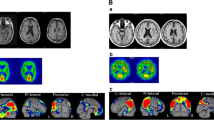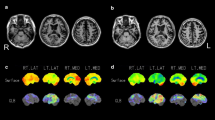Abstract
Patients with Parkinson’s disease (PD) may develop progressive dementia late in their clinical course. Dementia in PD is mostly related to neuropathological findings of extensive Lewy bodies (LBs), with or without the coexistence of Alzheimer’s disease (AD) pathology. Aphasia has been reported in patients with LB diseases with AD pathology; however, there have been no reports of typical PD patients developing progressive aphasia during their clinical course. We describe a female PD patient who later developed progressive conduction aphasia characterized by phonemic paraphasia and disturbance in repetition of short sentences without disturbance in writing or auditory comprehension. No episodes of fluctuations of attention, memory complaints, or planning errors were observed. She experienced episodes of visual hallucination. Her low scores on the Mini-Mental State Examination suggested impairment of orientation and attention, and her scores on Raven’s Coloured Progressive Matrices test indicated impaired visuospatial functions. However, her cognitive deficits were not sufficiently severe to impair her daily life. Brain magnetic resonance images revealed atrophy of the left superior temporal gyrus and widening of the left sylvian fissure. [18F]-fluorodeoxyglucose positron emission tomography revealed glucose hypometabolism in the left cerebral hemisphere. These findings may be related to conduction aphasia. During the progression of PD lesions, the brainstem LB is assumed to take an upward course, extend to the limbic system, and then extend to the neocortex. Conduction aphasia observed in our patient may be associated with an unusual progression of the LB pathology from the brainstem to the left temporoparietal lobe.

Similar content being viewed by others
References
Emre M, Aarsland D, Brown R et al (2007) Clinical diagnostic criteria for dementia associated with Parkinson’s disease. Mov Disord 22:1689–1707
Dubois B, Burn D, Goetz C et al (2007) Diagnostic procedures for Parkinson’s disease dementia: recommendations from the movement disorder society task force. Mov Disord 22:2314–2324
Goetz CG, Emre M, Dubois B (2008) Parkinson’s disease dementia: definitions, guidelines, and research perspectives in diagnosis. Ann Neurol 64(suppl):S81–S92
McKeith IG, Dickson DW, Lowe J et al (2005) Diagnosis and management of dementia with Lewy bodies, third report of the DLB consortium. Neurology 65:1863–1872
Henderson JM, Gai WP, Hely MA, Reid WGJ, Walker GL, Halliday GM (2001) Parkinson’s disease with late Pick’s dementia. Mov Disord 16:311–319
Caselli RJ, Beach TG, Sue LI, Connor DJ, Sabbagh MN (2002) Progressive aphasia with Lewy bodies. Dement Geriatr Cogn Disord 14:55–58
Monoshima S, Frey KA, Koeppe RA, Foster NL, Kuhl DE (1995) A diagnostic approach in Alzheimer’s disease using three-dimensional stereotactic surface projections of fluorine-18-FDG PET. J Nucl Med 36:1238–1248
Hughes AJ, Daniel SE, Kilford L, Lees AJ (1992) Accuracy of clinical diagnosis of idiopathic Parkinson’s disease: a cliniclo-pathological study of 100 cases. J Neurol Neurosurg Psychiatry 55:181–184
Yoshita M, Hayashi M, Hirai S (1998) Decreased myocardial accumulation of 123I-meta-iodobenzyl guanidine in Parkinson’s disease. Nucl Med Commun 19:137–142
Axer H, von Keyserlingk AG, Berks G, von Keyserlingk DG (2001) Supra- and infrasylvian conduction aphasia. Brain Lang 76:317–331
Kimura N, Kumamoto T, Hanaoka T, Hazama Y, Nakamura K, Arakawa R (2008) Corticobasal degeneration presenting with progressive conduction aphasia. J Neurol Sci 269:163–168
Matsui Y, Tanizaki Y, Arima H, Yonemoto K, Doi Y, Ninomiya T, Sasaki K, Iida M, Iwaki T, Kanba S, Kiyohara Y (2009) Incidence and survival of dementia in a general population of Japanese elderly: the Hisayama study. J Neurol Neurosurg Psychiatry 80:366–370
Papapetropoulos S, McCorquodale DS, Gonzalez J, Jean-Gilles L, Mash DC (2006) Cortical and amygdalar Lewy body burden in Parkinson’s disease patients with visual hallucinations. Parkinsonism Relat Disord 12:253–256
Burton EJ, McKeith IG, Burn DJ, Williams ED, O’Brien JT (2004) Cerebral atrophy in Parkinson’s disease with and without dementia: a comparison with Alzheimer’s disease, dementia with Lewy bodies and controls. Brain 127:791–800
Braak H, Del Tredici K, Rüb U, de Vos RAI, Jansen Steur ENH, Braak E (2003) Staging of brain pathology related to sporadic Parkinson’s disease. Neurobiol Aging 24:197–211
Author information
Authors and Affiliations
Corresponding author
Rights and permissions
About this article
Cite this article
Sakai, K., Ono, K., Harada, H. et al. Parkinson’s disease showing progressive conduction aphasia. Neurol Sci 33, 399–402 (2012). https://doi.org/10.1007/s10072-011-0751-9
Received:
Accepted:
Published:
Issue Date:
DOI: https://doi.org/10.1007/s10072-011-0751-9




